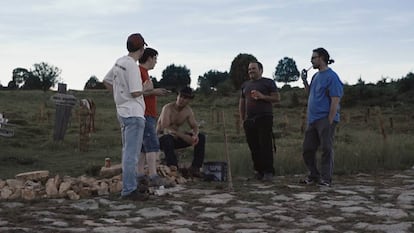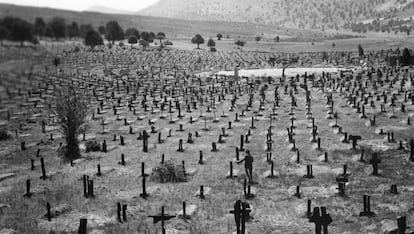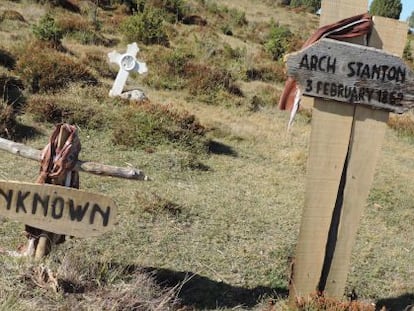Why people are dying for a place in this cinematic Spanish graveyard
Film buffs spark rush at location used in Eastwood movie ‘The Good, the Bad and the Ugly’
The Sad Hill cemetery, which was created 50 years ago in northern Spain to provide the backdrop for the climax of Clint Eastwood’s most famous Spaghetti Western, has people from all over the world prepared to pay to have their name on one of the headstones, according to the Spain-based Sad Hill Cultural Association, which has spent the last couple of years restoring the graveyard to its former glory.

Soon to be declared an Asset of Cultural Interest (BIC, to use its Spanish acronym), Sad Hill was allowed to fall into a state of disrepair after Sergio Leone’s The Good, The Bad And The Ugly wrapped in 1966. But, in a labor of love, volunteers have resurrected 1,500 of the 5,000 headstones that were carried there by the military during the Franco era and are now selling inscriptions for €15 a piece.
“There have even been American fans who have asked if we could scatter their ashes there when they die,” says David Alba, spokesman for the association. “If a blessing is needed from the Church, we can speak to Domingo Contreras, a priest from around here who appeared in the film when he was a kid!”
Ten days ago, we put up the last 100 headstones, and now we have 40 more on a waiting list David Alba, Sad Hill Cemetery Association
While the Tabernas desert in Almeria – which has provided the backdrop to westerns since the 1950s – is a designated Landscape of Cultural Interest and Natural Bird Sanctuary, Sad Hill, located close to Santo Domingo de Silos, about 30 kilometers southeast of the city of Burgos, in the region of Castilla y León, will be protected purely for its links to the movie world.
The regional government is due to trigger the process for the site to become a BIC, making it the first place in Spain to do so on purely cinematic grounds. It also has the distinction of being the only place to apply with only half a century of history behind it. This, according to Montse Moneo, a member of the association, is because cinema is a relatively new art.
The location was chosen during the unbearably hot summer of 1966, when director Sergio Leone moved the shooting of the third installment of his Dollars Trilogy to the rugged terrain of the Demanda mountains and the Arlanza valley in the plateau region near Burgos.
The movie was shot at four key locations in the vicinity: the San Pedro de Arlanza monastery, which became the San Antonio mission hospital; the River Pisuerga in Hortigüela which, in the film, is the site of the American Civil War battlefield; the suburbs of Carazo, which were transformed into the extensive prison camp of Betterville; and Santo Domingo de Silos, which was turned into Sad Hill Cemetery.
Thanks to the headstone scheme, the restoration is an ongoing project. “Ten days ago, we put up the last 100 headstones, and now we have 40 more on a waiting list, all applied for in June,” says Alba.

The association, which waits for 100 applications before embarking on the work needed to erect the headstones, believes that the sudden interest is linked to the fall release of Spanish director Guillermo de Oliveira’s new film, Sad Hill Unearthed.
The project began as a modest documentary about the revamping of the mocked-up cemetery, but it has turned into a more robust production featuring Clint Eastwood himself as well as the soundtrack’s composer, Ennio Morricone, and several members of the epic’s production team. It also features fans such as Álex de la Iglesia and Metallica frontman James Hetfield, who explains why all his concerts begin with music from the movie’s final scene.
The film shows the association’s volunteers starting work on the restoration of the cemetery with the idea there would be nothing left. But though locals had helped themselves to the headstones to build walls and crosses to reinforce roofs, the volunteers unearthed the cobbled square of around 40 meters in diameter that Sergio Leone used to organize the headstones – marked by no more than a line of knolls.
The shape of the graves was achieved by covering boxes with earth and the volunteers found these boxes, stitched to the ground by scrubs and weeds. Thanks to their efforts, Sad Hill is now more alive than ever with visitors making their way up the dirt track every weekend in homage to the cinema classic.
English version by Heather Galloway.
Tu suscripción se está usando en otro dispositivo
¿Quieres añadir otro usuario a tu suscripción?
Si continúas leyendo en este dispositivo, no se podrá leer en el otro.
FlechaTu suscripción se está usando en otro dispositivo y solo puedes acceder a EL PAÍS desde un dispositivo a la vez.
Si quieres compartir tu cuenta, cambia tu suscripción a la modalidad Premium, así podrás añadir otro usuario. Cada uno accederá con su propia cuenta de email, lo que os permitirá personalizar vuestra experiencia en EL PAÍS.
¿Tienes una suscripción de empresa? Accede aquí para contratar más cuentas.
En el caso de no saber quién está usando tu cuenta, te recomendamos cambiar tu contraseña aquí.
Si decides continuar compartiendo tu cuenta, este mensaje se mostrará en tu dispositivo y en el de la otra persona que está usando tu cuenta de forma indefinida, afectando a tu experiencia de lectura. Puedes consultar aquí los términos y condiciones de la suscripción digital.
More information










































